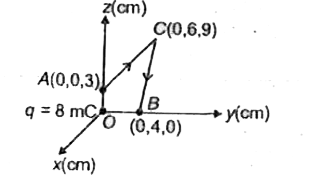A charge of mass 50 mg and carrying 5×10−9C is approaching a fixed charge 10×10−9C with a velocity point 0.5m/s .Find the maximum approch of the charge .
Step by step video & image solution for A charge of mass 50 mg and carrying 5xx 10^(-9)C is approaching a fixed charge 10 xx 10 ^(-9) C with a velocity point 0.5 m//s .Find the maximum approch of the charge . by Physics experts to help you in doubts & scoring excellent marks in Class 12 exams.
Topper's Solved these Questions
- BOOK - NN GHOSHCHAPTER - ELECTRIC FIELD AND POTENIALEXERCISE - EXERCISE21videos
ELECTRIC FIELD AND POTENIAL
- BOOK - NN GHOSHCHAPTER - ELECTRIC FIELD AND POTENIALEXERCISE - EXERCISE-B35videos
ELECTRIC FIELD AND POTENIAL
- BOOK - NN GHOSHCHAPTER - DYNAMO, MOTOR, TRANSFORMEREXERCISE - EXERCISE8videos
DYNAMO, MOTOR, TRANSFORMER
- BOOK - NN GHOSHCHAPTER - ELECTROMAGNETIC INDUCTIONEXERCISE - EXERICISES-B18videos
ELECTROMAGNETIC INDUCTION
Similar Questions
A particle of mass 40 mg and carrying a charge 5×10−9C is moving directly towards a fixed positive point charge on magnitude 10−8C. When it is at a distance of 10 cm from the fixed positive point charge it has a velocity of 50cms−1 at what distance from the fixed point charge will the particle come momentarily to rest ? Is the acceleration constant during motion?
View SolutionA particle of mass 400mg and charged with 5×10−9C is moving directly towards a fixed positive point charge of magnitude 10−8C. When it is at a distance of 10 cm from the fixed positive point charge it has a velocity of 50 cm/s. At what distance from the fixed point charge will the particle come momentarily to rest ? Is the acceleration constant during the motion ?
View Solution
Knowledge Check
- Question 1 - Select One
Is a charge of (5.8×10−18)C possible?
AyesBNoCMay beDCannot be determined - Question 2 - Select One
An electron having mass (9.1×10−31kg) and charge (1.6×10−19C) moves in a circular path of radius 0.5 m with a velocity 106m/s in a magnetic field. Strength of magnetic field is
A1.13×10−5TB5.6×10−5TC2.8×10−5TD3.6×10−5T - Question 3 - Select One
Calculate the work done in taking a charge −2×10−9C from A to B via C (in diagram )
 A0.2 jouleB1.2 jouleC2.2 jouleDzero
A0.2 jouleB1.2 jouleC2.2 jouleDzero
A proton of mass 1.67×10−27 kg and charge 1.6×10−19C is shot a uniform magnetic field, and perpendicular to the field with a velocity 5×106m/s. If the magnetic induction of the field is 1 tesla, find
(i) The radius of the circular pathView SolutionIf a lightning discharge lasts 1.4 ms and carries a current of 5.0×104 A through a potential difference of 2.4×109V. what is the change in the energy of the charge that is transferred by the discharge?
View SolutionA drop of water of mass 18×10−3 g falls away from the bottom of a charged conducting sphere of radius 20 cm, carrying with it a charge of 10−9C and leaving on the sphere a uniformly distributed charge of 2.5×10−6C. What is the speed of the drop after it has fallen 30 cm? (4πε0)−1=9×109JmC−2
View SolutionAn alpha particle of charge 3.2×10−19C and mass 6.8×10−27Kg is initially moving at speed 107ms when it is at far distance from another fixed point charge 112×10−19C. Find the distance of closest approach.
View SolutionTwo particles each have a mass of 6.0×10−3 kg. One has a charge of +5.0×10−6 C. and the other has a charge of −5.0×10−6 C. They are initially held at rest at a distance of 0.80 m apart. Both are then released and accelerate toward each other. How fast is each particle moving when the separation between them is one-third its initial value?
View Solution

